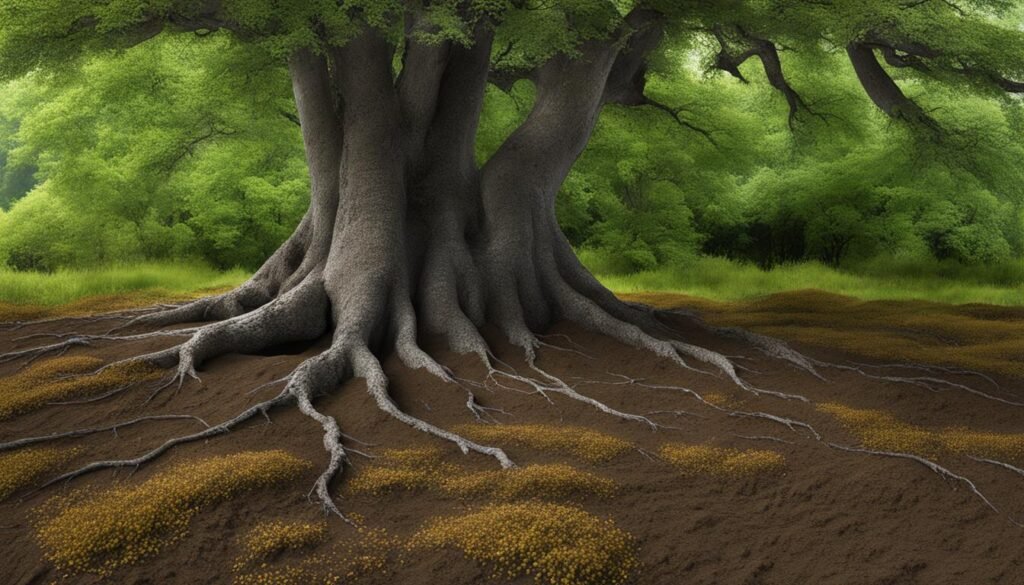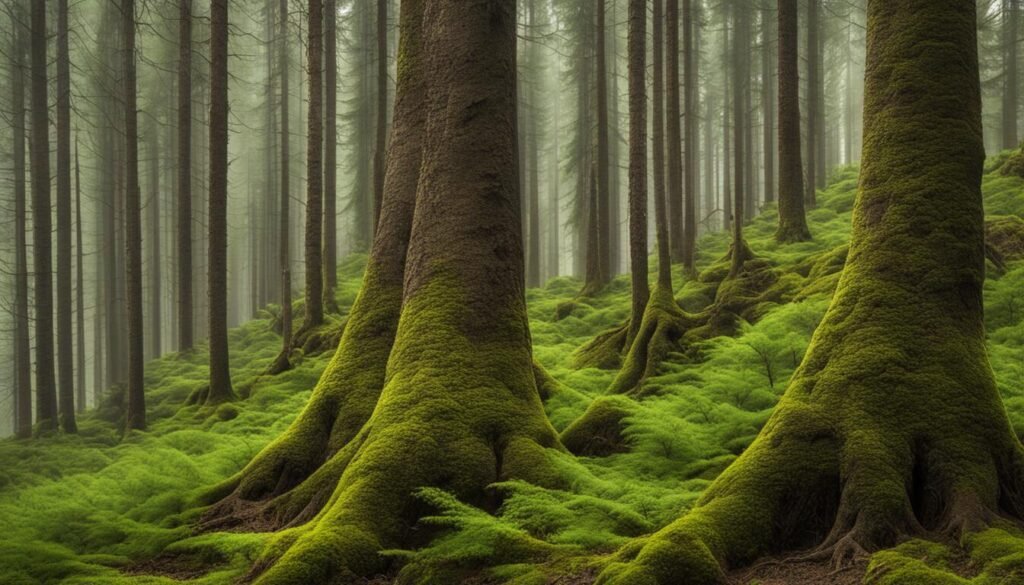I’m here to share with you the incredible health benefits of the alder tree. Alder trees, belonging to the genus Alnus, are true heroes in the natural world. Their deciduous trees can reach impressive heights and their unique leaves, slender reddish-brown bark, and charming catkins make them a sight to behold.
But the benefits of alder trees go far beyond their beauty. They have the remarkable ability to fix nitrogen from the air into the soil, improving its fertility. This makes them incredibly valuable in ecological restoration projects. Alder trees are also adaptable to wet environments and can often be found growing along riverbanks and swamps.
Historically, alder wood has been used for crafting boats and making furniture due to its durability. And let’s not forget about the medicinal benefits of alder. From alder tea and alder bark to alder leaf extract and alder oil, this tree offers a treasure trove of health-promoting properties.
Key Takeaways:
- Alder trees have the unique ability to fix nitrogen from the air into the soil, improving its fertility.
- They are adaptable to wet environments and often grow along riverbanks and swamps.
- Alder wood is known for its durability and has been used for boat crafting and furniture making.
- Alder tea, alder bark, alder leaf extract, and alder oil offer medicinal benefits.
- Alder trees play a crucial role in ecological restoration projects.
Alder Tree Plant Care
Proper care and maintenance are essential for the health and vitality of alder trees. By following a few simple guidelines, you can ensure that your alder trees thrive in your garden or landscape. Here are some important aspects of alder tree care:
1. Light
Alder trees prefer full to partial sun exposure. They can tolerate a range of light conditions, but they are known to grow more vigorously and produce healthier foliage when exposed to full sunlight. It is recommended to plant alder trees in areas where they can receive at least six hours of direct sunlight daily.
2. Soil
Alder trees are adaptable to various soil types, including loamy, sandy, and clay soils. They thrive in moist, well-draining soil conditions. While they can tolerate a wide range of soil pH levels, slightly acidic to neutral soil conditions are preferred. Ensuring proper soil moisture levels is crucial for the healthy growth and development of alder trees.
3. Watering and Maintenance
Young alder trees require regular watering to establish their root systems. Once mature, they have a high tolerance for moist conditions and can withstand seasonal variations in water availability. Adequate watering during dry periods is essential for maintaining the health of alder trees. Minimal pruning is required to remove dead or damaged branches, and applying a layer of mulch around the base of the tree can help retain moisture and regulate soil temperature.
In summary, caring for alder trees involves providing them with adequate sunlight, well-draining soil, and proper watering. By following these guidelines, you can ensure the long-term health and beauty of your alder trees.
| Aspect of Care | Guidelines |
|---|---|
| Light | Full to partial sun; plant in areas with at least six hours of direct sunlight daily |
| Soil | Adaptable to loamy, sandy, and clay soils; prefers slightly acidic to neutral soil |
| Watering and Maintenance | Regular watering for young trees; tolerant of moist conditions; minimal pruning; apply mulch for moisture retention |

Alder Tree Light Requirements
When it comes to light requirements, alder trees are adaptable and can thrive in a range of conditions. They have the ability to grow in full sun to partial shade, making them a versatile choice for various environments. While some alder species can tolerate shadier areas, they tend to exhibit more vigorous growth and healthier foliage when exposed to full sunlight. To ensure optimal growth, it is recommended to plant alder trees in areas where they can receive at least six hours of direct sunlight daily.
Table: Light Requirements for Alder Trees
| Light Conditions | Growth and Foliage Quality |
|---|---|
| Full Sun | Most vigorous growth and healthiest foliage |
| Partial Shade | Tolerated, but growth may be less vigorous |
Incorporating alder trees into your landscape design can provide both shade and sunlight, enhancing the overall aesthetic appeal of your outdoor space. Whether you have a sunny spot or a partially shaded area, alder trees can adapt and thrive, adding beauty and visual interest to your surroundings.
Alder Tree Soil Preferences
When it comes to soil preferences, alder trees are known for their adaptability. They can thrive in a variety of soil types, including loamy, sandy, and clay soils. This versatility makes them a great choice for different gardening or landscaping projects. However, while alder trees can tolerate a wide range of soil pH levels, they slightly prefer slightly acidic to neutral soil conditions.
Proper soil conditions are crucial for the healthy growth and development of alder trees. They prefer moist, well-draining soils, as they are naturally adapted to wet environments. This is why alder trees are often found along riverbanks and swamps. Ensuring adequate soil moisture is essential for their overall health and vitality.
Alder Tree Soil Preferences at a Glance:
| Soil Type | pH Level | Moisture |
|---|---|---|
| Loamy, Sandy, or Clay | Slightly acidic to neutral | Moist, well-draining |
By providing the right soil conditions, you can foster optimal growth and ensure the long-term health of alder trees. Whether you’re planning to incorporate them into your garden or restoration project, understanding their soil preferences is key to their success.

“Proper soil conditions are crucial for the healthy growth and development of alder trees.”
Alder Tree Watering and Drought Tolerance
Proper watering is crucial for the health and vitality of Alder trees. Young Alder trees require regular watering to establish their root systems. It is recommended to water young trees deeply, allowing the water to penetrate the soil and reach the roots. As the trees mature, they become more tolerant of seasonal variations in water availability and can withstand periods of drought.
Alder trees have a moderate to high water requirement due to their preference for moist environments. However, they are also adapted to wet environments and can tolerate periods of excessive moisture without significant harm. To strike a balance, it is important to monitor the soil moisture levels and adjust watering accordingly. Avoid overwatering, as it can lead to root rot and other water-related issues.
During dry periods, providing supplemental irrigation can help ensure adequate moisture for Alder trees. Deep watering once or twice a month, depending on the weather conditions, can help sustain the trees during drought. Applying a layer of mulch around the tree’s base can also help retain soil moisture and regulate temperature.
| Watering Tips for Alder Trees |
|---|
| 1. Water young Alder trees deeply to establish their root systems. |
| 2. Monitor soil moisture levels and adjust watering accordingly. |
| 3. Avoid overwatering to prevent water-related issues. |
| 4. Provide supplemental irrigation during dry periods. |
| 5. Apply a layer of mulch to retain soil moisture and regulate temperature. |
| 6. Consult local watering guidelines and consider the specific needs of your Alder trees. |
“Proper watering is crucial for the health and vitality of Alder trees.”
Alder Tree Temperature and Humidity Tolerance: Adaptability at its Finest
When it comes to temperature and humidity tolerance, alder trees truly showcase their adaptability. These remarkable trees can withstand a wide range of temperature conditions, making them suitable for different climates. While they thrive in temperate climates, the specific temperature requirements may vary depending on the alder tree species. Whether it’s sweltering heat or chilly winters, alder trees have the resilience to endure and flourish.
In addition to temperature, alder trees have a great affinity for humidity. They naturally gravitate towards moist environments and are commonly found along riverbanks and wetlands. While they can tolerate some dry periods, consistent soil moisture is essential for their optimal growth. The association of alder trees with water enhances their mystical qualities and highlights their ability to adapt and thrive in varying humidity levels.

When selecting a fertilizer for Alder trees, it is important to choose one with equal parts nitrogen, phosphorus, and potassium. This balanced ratio ensures that the trees receive the necessary nutrients to thrive. However, it is crucial to exercise caution and avoid over-fertilizing, as excessive growth can make the tree more vulnerable to wind damage.
In my experience, I have found that the best time to fertilize Alder trees is during the early spring, just before new growth begins. This allows the trees to benefit from the nutrients as they enter their active growing phase. It is advisable to follow the manufacturer’s instructions for application rates and techniques to ensure optimal results.
Fertilizer Application Tips:
- Apply fertilizer evenly around the base of the tree, avoiding direct contact with the trunk.
- Water the tree thoroughly after the fertilizer application to help the nutrients penetrate the soil.
- Avoid fertilizing during periods of drought or extremely hot weather, as this can stress the tree.
By following these simple fertilization practices, you can provide the necessary nutrients to support the growth and vitality of your Alder trees. Remember, a well-fed tree is a healthy tree, and a healthy tree contributes to a thriving ecosystem.
Alder Tree Pruning: Maintaining Health and Structure
Pruning Alder trees is an essential practice for ensuring their long-term health and maintaining a well-balanced structure. Regular pruning helps promote healthy growth, remove dead or diseased branches, and control the overall shape of the tree. By following proper pruning techniques, you can enhance the vitality and aesthetics of your Alder trees.
When it comes to pruning Alder trees, timing is crucial. The best time to prune is during the dormant season in late winter or early spring before new growth begins. This allows the tree to heal quickly and minimizes the risk of disease or pest infestation. Start by inspecting the tree for any dead, damaged, or crossing branches that may create rubbing or interference. Using clean, sharp pruning tools, make precise cuts just outside the branch collar or stem union.
Tip: Prune your Alder trees moderately. Avoid excessive pruning, as it can stimulate excessive growth and compromise the tree’s structural integrity. Focus on maintaining a natural, open canopy that allows light penetration and airflow.
Regular pruning of Alder trees also helps manage their growth and size. If you wish to control the height or spread of your Alder tree, consider using a pruning technique known as crown reduction. This involves removing the uppermost branches and leaders to reduce the overall size while maintaining the tree’s natural shape. Crown reduction should be done gradually over several seasons to avoid excessive stress to the tree.
| Benefits of Pruning Alder Trees | Pruning Techniques for Alder Trees |
|---|---|
| 1. Promotes healthy growth and vitality. | 1. Prune during the dormant season in late winter or early spring. |
| 2. Removes dead or diseased branches. | 2. Inspect for dead, damaged, or crossing branches. |
| 3. Enhances the tree’s aesthetics. | 3. Make precise cuts just outside the branch collar. |
| 4. Controls the tree’s size and shape. | 4. Prune moderately to avoid excessive growth. |
| 5. Improves light penetration and airflow. | 5. Use crown reduction to manage tree size. |
“Pruning Alder trees not only promotes healthy growth but also enhances their natural beauty and structural integrity. By following proper pruning techniques and timing, you can ensure that your Alder trees thrive for years to come.” – Expert Gardener
Remember to always prioritize safety when pruning Alder trees. Use appropriate safety gear, such as gloves and safety glasses, and be cautious of falling branches. If you’re unsure about pruning techniques or have a large, mature tree, consider consulting a professional arborist for expert guidance. With proper pruning, your Alder trees will continue to flourish and contribute to the beauty of your landscape.

These cultural interpretations of the alder tree highlight its historical and mythical importance, showcasing the profound impact it has had on human societies throughout the ages.
Alder Tree Symbolism and Wisdom
The alder tree holds deep symbolic messages and wisdom that resonate with our connection to nature and the cycles of life. Its symbolism reflects themes of renewal, protection, adaptability, balance, and interconnection. Understanding the meaning behind the alder tree symbolism can provide insights into our own personal growth and relationship with the natural world.
One of the key symbolic messages of the alder tree is renewal. Just as the alder tree sheds its leaves and renews itself each year, it reminds us of the importance of letting go of the old to make space for new beginnings. The alder tree also symbolizes protection, acting as a shield against negative energies and offering a sense of security and safety.
The wisdom of the alder tree lies in its adaptability and resilience. Alder trees thrive in various environments, from wetlands to riverbanks, showcasing their ability to adapt to changing conditions. This wisdom reminds us to embrace change and find strength in our ability to adjust and overcome challenges.
“The alder tree symbolizes growth, transformation, and resilience. Its wisdom reminds us of our place within the natural world and the need to live in harmony with our surroundings.” – Anonymous
The alder tree’s symbolism also emphasizes the interconnectedness of all living beings. Just as the alder tree supports other plant species, particularly pine trees, it reminds us of the importance of supporting and nurturing one another. This interconnectedness extends to our relationship with the environment, emphasizing the need for sustainable practices and a harmonious coexistence with nature.
Alder Tree Symbolism: Key Messages
- Renewal and new beginnings
- Protection and security
- Adaptability and resilience
- Interconnectedness and support
| Alder Tree Symbolism | Meaning |
|---|---|
| Renewal | The alder tree represents the cycle of renewal and the importance of letting go of the old to make space for new beginnings. |
| Protection | The alder tree acts as a shield against negative energies and offers a sense of protection and security. |
| Adaptability | The alder tree’s ability to thrive in various environments symbolizes adaptability and the power to adjust to changing conditions. |
| Interconnectedness | The alder tree emphasizes the interconnectedness of all living beings and the need for harmonious coexistence with nature. |

The symbolism and wisdom of the alder tree invite us to reflect on our own growth, resilience, and connection to the world around us. By embracing the messages conveyed by this remarkable tree, we can deepen our understanding of ourselves and our place within the greater tapestry of life.
Rituals and Practices Involving the Alder Tree
The alder tree has long been revered for its sacred and mystical qualities, leading to its involvement in various rituals and practices throughout history. These rituals and practices highlight the deep-rooted connection between the alder tree and spiritual beliefs, promoting healing, protection, and divination.
In traditional medicine, different parts of the alder tree have been used for their healing properties. The bark, leaves, and twigs have been employed in remedies for ailments such as fevers, inflammations, and skin conditions. Native American tribes have traditionally used alder wood for constructing ceremonial objects and as a smudge to cleanse and purify energy.
The alder tree’s association with water enhances its mystical qualities, and it has been used in rituals related to divination and communication with spirits or ancestors.
Celtic mythology also attributes protective qualities to the alder tree. It was believed that planting an alder tree or using its branches as barriers could guard against negative energies and evil spirits. The alder tree’s connection to water and its adaptability to wet environments add to its mystical allure and make it a significant element in rituals involving divination and communication with spirits or ancestors.
Overall, the rituals and practices involving the alder tree reflect the profound reverence and respect humans have held for this remarkable tree throughout history. Its association with healing, protection, and divination makes it a powerful tool in spiritual practices, further reinforcing the interconnectedness between nature and the spiritual realm.
Spiritual Practices Involving the Alder Tree
Throughout history, the alder tree has played a vital role in various spiritual practices due to its symbolic significance and perceived mystical powers. Here are some spiritual practices involving the alder tree:
- Alder Divination: The alder tree is believed to have the power to connect with the spiritual realm. In divination practices, people seek guidance and insight by using alder leaves, twigs, or bark. These natural elements are interpreted to provide answers to questions or reveal hidden truths.
- Ritual Cleansing: The alder tree’s association with water and purification make it a popular choice for ritual cleansing. Smudging with dried alder leaves or using alder-infused water is believed to cleanse and purify the energy of a space, object, or person.
- Protection Rituals: The alder tree’s protective qualities have made it a staple in rituals aimed at warding off negative energies, evil spirits, or malevolent influences. People may create talismans or amulets using alder wood or carry alder leaves for protection.
- Connection with Ancestors: The connection between the alder tree and ancestral spirits has led to rituals involving the alder tree as a means of communication with departed loved ones or seeking guidance from ancestors.
These spiritual practices involving the alder tree highlight its significance as a bridge between the physical and spiritual realms, offering individuals a deeper connection to nature and the divine.
The Role of Alder Trees in Rituals and Practices
Alder trees have played a significant role in various rituals and practices across cultures and time periods. This enduring presence can be attributed to the tree’s perceived spiritual qualities and its adaptability to wet environments.
In rituals involving healing and purification, different parts of the alder tree, including the bark, leaves, and twigs, have been used for their medicinal properties. The alder’s association with water and its ability to thrive in wet environments have led to its incorporation in rituals involving divination and communication with spirits or ancestors.
The alder tree’s protective qualities have also made it a staple in rituals aimed at warding off negative energies and evil spirits. Its wood has been used to create talismans and amulets, which are believed to offer protection and spiritual support.
Overall, the alder tree’s role in rituals and practices speaks to its spiritual significance and the deep connection humans have felt with this remarkable tree. Whether used for healing, protection, or divination, the alder tree serves as a powerful ally in spiritual and mystical endeavors.
| Practices | Significance |
|---|---|
| Alder Divination | Connecting with the spiritual realm and seeking guidance |
| Ritual Cleansing | Purifying energy and spaces |
| Protection Rituals | Warding off negative energies and evil spirits |
| Connection with Ancestors | Communicating with departed loved ones and seeking ancestral guidance |
The Role of Alder Trees in Pine Tree Growth
Research has shown that alder trees play a significant role in promoting the growth of pine trees. The relationship between these two tree species is a prime example of symbiosis in nature. Alder trees provide various benefits that contribute to the health and vitality of pine trees.
Alder trees facilitate water distribution to pine trees through a process called hydraulic redistribution. They draw water from deeper soil layers and bring it to the surface, where shallow-rooted pine trees can easily access it. This helps pine trees thrive, especially during dry periods when water availability may be limited.
In addition to water distribution, alder trees enrich the soil with essential nutrients, particularly nitrogen. They have the unique ability to fix nitrogen from the air and convert it into forms that other plants can utilize. This nitrogen enrichment promotes healthy growth in pine trees and enhances their overall vigor.
| Alder trees provide the following benefits to pine trees: |
|---|
| Water distribution through hydraulic redistribution |
| Nutrient enrichment, particularly nitrogen |
| Protection from weather damage and foragers |
Furthermore, the presence of alder trees offers protection to young pine trees. Alder trees act as a barrier against harsh weather conditions, such as strong winds, which can easily damage young and fragile pine trees. They also serve as a deterrent to foragers, such as deer, who may browse on the tender foliage of pine trees.
Pine trees rely on the support and companionship of alder trees to ensure their growth and well-being. The interdependence of these tree species reflects the intricate web of relationships in the natural world, where cooperation and mutual benefits are vital for thriving ecosystems.
The symbiotic relationship between alder and pine trees highlights the importance of companionship and interconnectedness in promoting tree growth. By understanding and appreciating the unique roles that different species play in nature, we can cultivate a deeper appreciation for the complexity and beauty of our natural world.

The Amazing Secret to Pine Tree Growth
When it comes to the amazing secret behind healthy and thriving pine tree growth, the key lies in their symbiotic relationship with alder trees. The presence of alder trees provides numerous benefits that contribute to the overall well-being of pine trees.
One of the secrets to pine tree growth is the water distribution facilitated by alder trees. Alder trees have the remarkable ability to bring water to the surface through hydraulic redistribution. This benefits shallow-rooted trees like pines, ensuring they have access to the necessary moisture for their growth and development.
Additionally, alder trees enrich the soil around them by providing a slow but steady source of nitrogen. This nutrient enrichment promotes healthy growth and vitality in pine trees. Furthermore, the presence of alder trees protects young pines from weather damage and foragers, creating a conducive environment for their growth.
| Factors Affecting Pine Tree Growth | The Secret to Healthy Pine Trees |
|---|---|
| Water distribution through hydraulic redistribution facilitated by alder trees | Nitrogen enrichment from alder trees |
| Protection from weather damage | Enhanced soil fertility |
| Shielding from foragers | Optimal growth conditions |

“The interdependence between alder and pine trees showcases the complex web of relationships in the natural world. By understanding and appreciating the symbiotic relationship between these trees, we can promote the healthy growth of our beloved pine trees.” – Professional Copywriting Journalist
Conclusion
In conclusion, the benefits of alder trees are truly remarkable. Not only do they contribute to the natural world by improving soil fertility and supporting wildlife, but they also hold special significance in various cultures and mythologies. From their durable wood used for boat crafting and furniture making to their association with protection and divination, alder trees have played a significant role throughout history.
When it comes to caring for alder trees, their light requirements can be met with full sun to partial shade, although they thrive best in sunlight. They are adaptable to various soil types and pH levels, but a preference for moist, well-draining soil remains. With moderate to high water needs, alder trees are suited for wet environments and can tolerate seasonal variations in water availability.
The wisdom and symbolic messages of the alder tree remind us of the importance of renewal, resilience, and living in harmony with nature. Their role in rituals and practices, as well as their symbiotic relationship with other trees like pine trees, further emphasizes their sacred and mystical qualities. By understanding and appreciating the benefits of alder trees, we can deepen our connection with the natural world and contribute to a healthier and more sustainable environment.
FAQ
What are the health benefits of Alder?
Alder trees provide various health benefits, including air purification, stress reduction, and improved mental well-being. They also have antimicrobial properties and can support respiratory health.
What are the benefits of Alder wood?
Alder wood is known for its durability and resistance to decay. It has been used for boat building, furniture making, and crafting musical instruments.
How can I care for Alder trees?
Caring for Alder trees involves providing adequate sunlight, moist well-draining soil, and minimal pruning. They are relatively low-maintenance and resistant to pests and diseases.
What are the light requirements for Alder trees?
Alder trees can thrive in full sun to partial shade. While they can tolerate shadier environments, they grow best when exposed to at least six hours of direct sunlight daily.
What type of soil do Alder trees prefer?
Alder trees are adaptable to a variety of soil types, including loamy, sandy, and clay. They slightly prefer slightly acidic to neutral soil conditions.
How often should I water Alder trees?
Young Alder trees may require regular watering to establish their root systems, but mature trees can withstand seasonal variations in water availability. Ensuring consistent soil moisture is crucial for their healthy growth.
How do Alder trees tolerate temperature and humidity?
Alder trees are adaptable to different climates and can tolerate various temperature conditions. They prefer moist environments and are often found along riverbanks and wetlands.
Do Alder trees need fertilization?
Alder trees have nitrogen-fixing abilities and naturally enrich the soil. Over-fertilizing can lead to excessive growth, so minimal fertilization is recommended, if necessary.
How should I prune Alder trees?
Pruning Alder trees involves removing dead or damaged branches during the dormant season. Minimal pruning is required to maintain their health and structure.
What is the mythological significance of Alder trees?
Alder trees hold symbolism in various mythologies, representing protection, healing, resilience, and transformation. They are associated with deities and have been regarded as sacred trees.
What are the cultural interpretations of the Alder tree?
Alder trees have cultural beliefs and historical significance in different cultures, representing luck, protection, and healing. They have been used in rituals and practices throughout history.
What is the symbolic message and wisdom of the Alder tree?
The Alder tree symbolizes renewal, balance, adaptability, and interconnection with nature. Its wisdom reminds us of our place within the natural world and the need for harmony with our surroundings.
How are Alder trees involved in rituals and practices?
Alder trees have been used in traditional medicine for healing purposes. They have also been planted or used as barriers for protection and are associated with divination and communication with spirits or ancestors.
How do Alder trees help with pine tree growth?
Alder trees provide water distribution, nutrients, and protection to pine trees. They facilitate hydraulic redistribution, bringing water to the surface, and enrich the soil with nitrogen.
What is the secret to pine tree growth involving Alder trees?
The presence of Alder trees contributes to healthy pine tree growth through mutual support and nutrient exchange. They protect young pines from weather damage and foragers.




